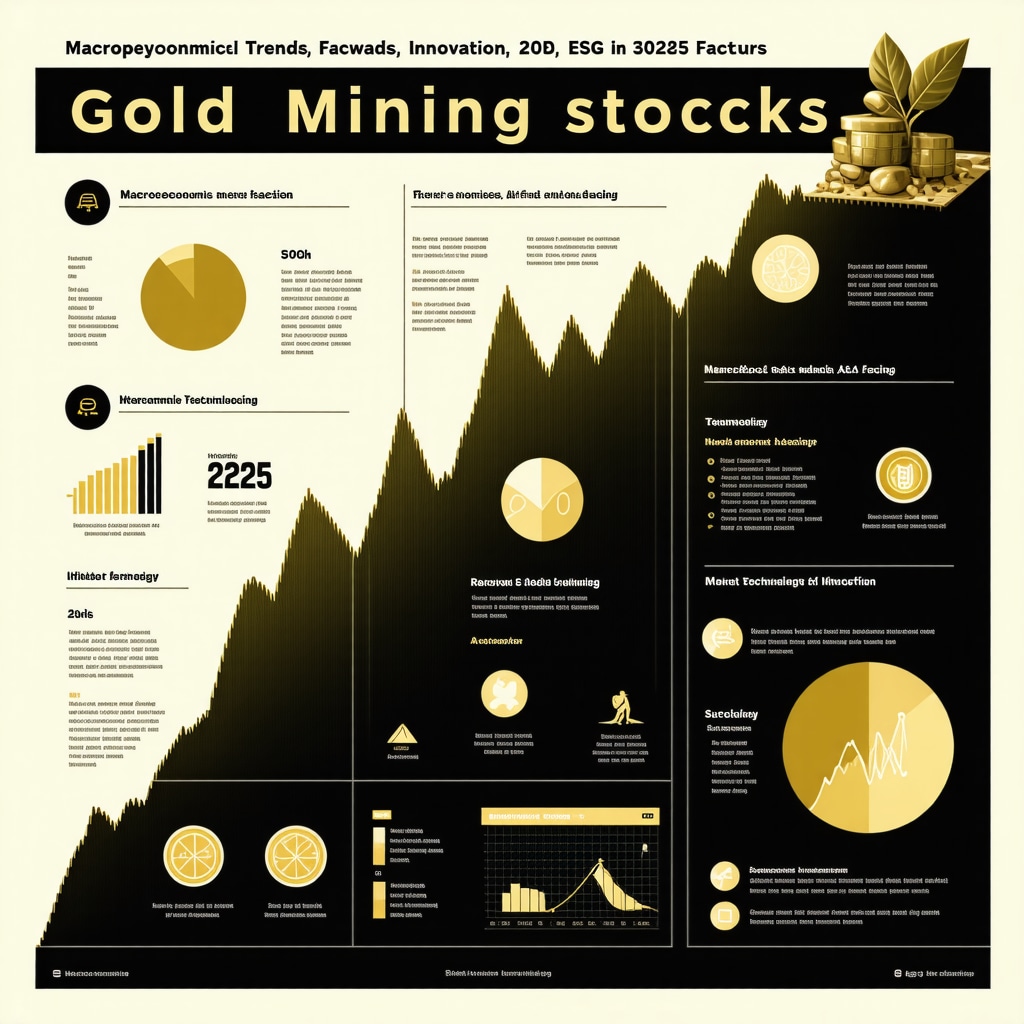Why Gold Mining Stocks Are Like a Box of Chocolates—You Never Know What You’re Gonna Get
Picture this: you’re at a bustling café, sipping your espresso and overhearing a heated debate about gold. Not the shiny trinket kind, but the investment kind. Specifically, gold mining stocks. They sparkle with promise but come with their own set of quirks. Investing in gold mining stocks is a tale of high stakes and glittering rewards, tangled with risks that can make even seasoned investors sweat.
Unlike just buying gold bullion or ETFs, owning shares in gold mining companies means you’re buying into the business of unearthing the shiny metal itself. It’s not just gold price movements you’re betting on but also management efficiency, geopolitical risks, operational challenges, and even environmental regulations. That’s where the thrill — and peril — truly lie.
Digging Deeper: What Makes Gold Mining Stocks Tick?
Gold mining stocks are inherently linked to the price of gold, but they dance to a slightly different rhythm. When gold prices soar, miners often see their profits multiply, but if costs spike or mines underperform, those shiny returns can quickly dull.
One fascinating aspect is leverage. Mining stocks can outperform the price of gold because they amplify gains (and losses). Imagine gold prices rising 10%; a well-run mining stock might jump 20% or more. But the flip side? When prices tumble, those same stocks can plunge even harder.
Is Investing in Gold Mining Stocks Just a Gamble in Disguise?
It’s a question worth asking. Are you placing a savvy bet on a sector with real growth potential, or just spinning the roulette wheel? Consider that mining operations face unpredictable hurdles: labor strikes, fluctuating extraction costs, political instability in mining regions, and environmental scrutiny. These factors can cause stock volatility independent of gold’s own price swings.
However, with risk comes opportunity. Expert analysis from sources like Investopedia’s guide on gold mining stocks highlights how investors who carefully research the company’s fundamentals, reserve life, and cost structures can uncover genuine gems in this sector.
Balancing Act: How to Weigh Risks Against Rewards
Investors attracted to gold mining stocks often seek portfolio diversification and a hedge against inflation. But diversifying isn’t just about adding gold stocks blindly; it’s about understanding the interplay between supply and demand, extraction costs, and global economic shifts. For a sharper edge, explore how gold mining stocks compare to gold ETFs, which offer a more direct play on gold prices without company-specific risks.
Moreover, savvy investors keep an eye on broader market drivers, including geopolitical tensions and central bank gold buying patterns, which can dramatically sway prices and mining stock performance. For the curious, understanding gold supply and demand dynamics can be a game-changer in timing your investments.
So, Are Gold Mining Stocks Worth the Gold Rush?
That depends on your appetite for risk and your investment horizon. Patience and research can turn this volatile sector into a rewarding avenue, but a knee-jerk plunge without due diligence could leave you panning for fools’ gold.
What’s your take? Have you struck gold with mining stocks or found the pitfalls too treacherous? Share your experiences and thoughts below — let’s dig into this together.
What Drives the Volatility in Gold Mining Stocks Beyond Gold Prices?
While gold mining stocks are often perceived as a straightforward proxy for gold prices, the reality is far more nuanced. Beyond the bullion price, these stocks are influenced by operational risks such as mine depletion rates, unexpected cost overruns, and technological advancements in extraction. For instance, a mine with a longer reserve life and lower cost per ounce mined typically enjoys more stable stock performance regardless of short-term gold price fluctuations.
Another pivotal factor is geopolitical stability. Mines located in politically volatile regions face production disruptions, impacting cash flow and investor confidence. Environmental regulations are tightening worldwide, imposing additional compliance costs and potential shutdown risks. These elements intertwine to create a complex risk matrix that investors must decode to make informed decisions.
For those seeking a deeper dive into how these dynamics interplay with gold’s broader economics, analyzing global gold supply and demand offers critical insights for smarter investing.
Evaluating Gold Mining Companies: What Metrics Truly Matter?
Investment pros tend to focus on several key performance indicators when assessing gold mining stocks. These include the All-In Sustaining Costs (AISC) per ounce, cash flow generation, production growth potential, and debt levels. A company with low AISC and robust cash flow can weather gold price downturns more effectively, preserving shareholder value.
Reserve life is another crucial metric. Mines with longer projected lifespans ensure continued production and revenue streams, which can justify premium valuations. Conversely, companies nearing the end of their reserve life may face declining outputs and increasing costs, signaling caution.
Management quality cannot be overstated. Experienced leadership teams with a track record of navigating commodity cycles and operational challenges often outperform peers. Transparent communication and strategic capital allocation also signal corporate health.
How Can Investors Harness Gold Mining Stocks to Enhance Portfolio Resilience in 2025?
Given the multifaceted risk-reward profile of gold mining stocks, how can investors effectively integrate them into their portfolios? Diversification remains paramount. Combining mining stocks with physical gold, ETFs, or mutual funds can balance exposure between operational risks and pure commodity plays.
Moreover, timing entry points by monitoring macroeconomic indicators—such as inflation trends, currency strength, and central bank gold purchases—can optimize returns. For example, central bank buying has historically provided bullish momentum for gold and related equities, as detailed in World Gold Council’s demand trends report.
Active investors might also explore tactical allocation shifts during market volatility, leveraging strategies outlined in effective gold trading strategies for volatile markets.
Engage with this complex asset class by sharing your strategies or questions below. How do you balance the allure of gold mining stocks against their inherent risks? Your insights might just help fellow investors strike gold.
Decoding the Impact of Technological Innovation on Gold Mining Profitability
Technological advancements have become a game-changer in the gold mining sector, reshaping profitability dynamics and operational efficiency. Innovations such as autonomous drilling, real-time data analytics, and AI-powered predictive maintenance are not only reducing operational costs but also improving safety and extending mine life. Companies embracing these cutting-edge technologies tend to achieve lower All-In Sustaining Costs (AISC) and enhanced ore recovery rates, which can translate into superior stock performance even amidst volatile gold price environments.
For example, remote sensing and machine learning algorithms enable precise geological mapping, providing mining companies with a clearer picture of ore bodies and optimizing extraction processes. This precision mitigates risks associated with overestimating reserves or encountering unexpected operational challenges. Investors should therefore assess a mining company’s technological adoption as a critical qualitative metric alongside traditional financial indicators.
Risk Mitigation Through Strategic Hedging: Sophisticated Financial Instruments in Gold Mining Stocks
While gold mining stocks inherently carry exposure to gold price fluctuations, many firms employ sophisticated hedging strategies to stabilize earnings. Futures contracts, options, and swaps are commonly used to lock in prices for a portion of production, shielding cash flow from adverse market movements. However, these strategies can be a double-edged sword; overly aggressive hedging can cap upside potential during gold rallies.
Investors evaluating gold mining companies should scrutinize the extent and nature of hedging in place. Transparent disclosure of hedging policies, maturities, and counterparty credit risk is vital. A balanced hedging approach often signals prudent management aiming to navigate cyclicality without sacrificing growth opportunities.
How Do Environmental, Social, and Governance (ESG) Criteria Influence Gold Mining Investment Decisions?
ESG considerations have emerged as a pivotal factor influencing investor sentiment and capital flow into gold mining stocks. Firms with strong ESG practices often benefit from reduced regulatory risks, enhanced community relations, and improved access to capital markets. Conversely, companies with poor environmental records or social conflicts may face costly shutdowns, litigation, or reputational damage.
Leading research from the MSCI ESG Investing framework reveals that gold miners proactively addressing ESG risks tend to outperform peers over the long term. Incorporating ESG analysis into due diligence can therefore provide an additional layer of risk assessment and value identification.
Leveraging Macroeconomic Indicators and Central Bank Gold Policies for Tactical Allocation
Seasoned investors harness macroeconomic signals such as interest rate trajectories, inflation expectations, and currency fluctuations to time their allocations in gold mining stocks. Notably, central bank gold purchase trends have a profound impact on market dynamics. For instance, sustained buying by emerging market central banks can signal robust demand fundamentals, potentially lifting gold prices and mining equities alike.
Utilizing data from the World Gold Council’s central bank net purchases report enables investors to anticipate supply-demand imbalances and adjust their portfolios proactively. Combining these insights with technical analysis and company-specific fundamentals can create a holistic strategy to exploit cyclical opportunities.
Innovative Portfolio Construction: Integrating Gold Mining Stocks with Alternative Assets
Beyond traditional diversification, integrating gold mining stocks with alternative assets such as private equity in mining ventures, royalty and streaming companies, or commodity-linked derivatives offers nuanced exposure profiles. Royalty companies, for example, provide leverage to gold prices with lower operational risks, complementing direct mining stock holdings.
This layered approach can smooth portfolio volatility and enhance risk-adjusted returns. However, it requires advanced understanding of each asset class’s risk drivers and correlation behaviors.
What Are the Most Effective Metrics for Predicting Long-Term Success in Gold Mining Ventures?
While metrics like AISC and reserve life are foundational, leading analysts advocate incorporating forward-looking indicators such as exploration success rates, geopolitical risk indices, and innovation adoption scores. Quantitative models integrating these parameters yield more robust forecasts of company resilience and growth potential.
Diving into specialized resources like the S&P Global Market Intelligence mining analytics can empower investors with data-driven insights beyond surface-level evaluations.
To truly master gold mining stock investing, continuous learning and engagement with expert analyses is indispensable. Join our newsletter for advanced market updates and exclusive interviews with industry insiders.
When the Dust Settles: How Do Macro-Trends Really Shape Gold Mining Stocks?
Gold mining stocks don’t exist in a vacuum. The sweeping macroeconomic trends—from inflation trajectories and currency fluctuations to geopolitical upheavals—cast long shadows over their valuations. For instance, the relentless march of inflation often boosts gold’s allure as a safe haven, but mining stocks respond with added complexity. Operational costs such as energy and labor can simultaneously rise, squeezing margins. Recognizing this duality is essential for nuanced portfolio positioning.
Moreover, central bank policies, especially sustained gold purchases by emerging economies, continue to tighten supply-demand dynamics, providing underlying support to mining equities. The World Gold Council’s demand trends report remains a must-read resource for investors aiming to decode these macro-drivers and anticipate market inflection points.
Innovative Financial Instruments: Can Royalty and Streaming Companies Offer Safer Shores?
For investors wary of direct operational risks inherent in mining companies, royalty and streaming firms represent a compelling alternative. These entities finance mining operations in exchange for a percentage of production or revenue, sidestepping many day-to-day challenges of extraction. The result? Exposure to gold price upside with mitigated geopolitical and operational risks.
This strategy can smooth portfolio volatility and deliver consistent cash flows, especially during turbulent market phases. Integrating royalty and streaming company stocks alongside traditional mining equities forms a layered approach to gold investment, balancing risk and reward effectively.
How Do Emerging Technologies in Exploration and Sustainability Transform Gold Mining Investment Potential?
Emerging technological breakthroughs, particularly in sustainable mining practices and exploration efficiency, are reshaping the gold sector’s investment landscape. Advanced geospatial analytics, AI-driven mineral discovery, and eco-friendly extraction methods not only improve profitability but also address growing ESG concerns.
Companies pioneering these innovations often enjoy better regulatory relationships and community goodwill, translating into lower compliance costs and enhanced long-term viability. Investors evaluating gold mining stocks should weigh a firm’s technological adoption and sustainability credentials as pivotal criteria, beyond conventional financial metrics.
For a thorough understanding of how supply-demand trends and ESG factors intertwine with gold market dynamics, explore our in-depth analysis on why gold supply and demand trends matter for your portfolio.
Mastering Volatility: Tactical Allocation Tips from Industry Veterans
Seasoned investors advocate a tactical approach to gold mining stocks, selectively increasing exposure during early signs of inflationary pressures or geopolitical tensions, and trimming positions when market exuberance peaks. Utilizing advanced technical indicators alongside fundamental analysis—such as production growth forecasts and All-In Sustaining Costs (AISC)—can sharpen timing and risk management.
Resources like effective gold trading strategies for volatile markets offer invaluable frameworks to navigate the sector’s inherent swings with greater confidence.
We invite you to share your own strategies or challenges with gold mining stock investing in the comments below. How do you balance operational risks with gold price exposure in your portfolio? Your insights could spark a valuable dialogue among fellow investors.

Expert Insights & Advanced Considerations
Leverage Technological Innovation as a Competitive Moat
Mining companies that invest in cutting-edge technologies such as AI-driven exploration, autonomous equipment, and real-time data analytics gain measurable advantages in cost reduction and operational efficiency. These innovations not only lower All-In Sustaining Costs (AISC) but also extend mine life and improve ore recovery, creating a durable moat that can enhance stock resilience amid gold price volatility.
Integrate ESG Factors for Sustainable Investment Decisions
Environmental, social, and governance (ESG) criteria have become essential in evaluating gold mining stocks. Companies with robust ESG practices tend to face fewer regulatory disruptions and enjoy stronger community relationships, mitigating risks that traditional financial metrics might overlook. This integration of ESG analysis into due diligence can uncover undervalued opportunities and support long-term portfolio stability.
Use Macroeconomic and Central Bank Signals to Inform Tactical Allocation
Monitoring macroeconomic indicators like inflation trends, currency movements, and central bank gold purchases is critical for timing investments in gold mining stocks. Central bank buying patterns, especially from emerging markets, often presage shifts in gold demand that can create favorable entry or exit points. Combining these signals with company fundamentals sharpens tactical allocation strategies.
Balance Exposure with Royalty and Streaming Companies
For investors seeking gold price leverage with moderated operational risks, royalty and streaming firms provide a compelling complement to direct mining stocks. These entities offer consistent cash flows and reduced geopolitical exposure, smoothing portfolio volatility while maintaining upside participation in gold price appreciation.
Leverage Forward-Looking Metrics Beyond Traditional Indicators
In addition to All-In Sustaining Costs and reserve life, incorporating forward-looking metrics such as exploration success rates, innovation adoption levels, and geopolitical risk indices can enhance predictive accuracy for long-term company performance. Data-driven platforms like S&P Global Market Intelligence mining analytics provide invaluable insights for sophisticated investors.
Curated Expert Resources
- World Gold Council Research Hub: Offers comprehensive data on global gold demand trends, central bank purchases, and market forecasts, essential for macro-level analysis (gold.org).
- MSCI ESG Investing Framework: Provides detailed ESG ratings and analytics critical for assessing mining companies’ sustainability practices and risks (msci.com).
- S&P Global Market Intelligence Mining Analytics: Supplies advanced mining-specific data, including operational, financial, exploration, and geopolitical risk metrics, enabling nuanced investment decisions (snl.com).
- BuyingGoldNow’s In-Depth Guides: Particularly valuable are the analyses on why gold supply and demand trends matter for your portfolio and effective gold trading strategies for volatile markets, which blend practical insight with market intelligence.
- Investopedia’s Gold Mining Stocks Guide: A foundational resource for understanding the basic mechanics and risks inherent in gold mining equities (investopedia.com).
Final Expert Perspective
Gold mining stocks present a multifaceted investment landscape where operational efficiency, technological innovation, ESG considerations, and macroeconomic forces converge. Mastery lies in transcending simplistic gold price correlations to embrace a holistic view—one that evaluates the interplay of cost structures, geopolitical risks, sustainability credentials, and central bank dynamics. By integrating these advanced insights, investors can better position themselves to harness the sector’s growth potential while mitigating volatility.
For those serious about refining their approach, delving into detailed analyses such as gold supply and demand explained for smarter investing and exploring top gold mining stocks to watch for 2025 is a prudent next step. Share your expert perspectives, questions, or experiences below—engaging with this dynamic community enriches everyone’s understanding and sharpens investment acumen.










